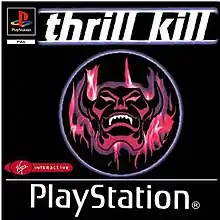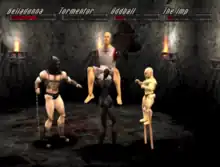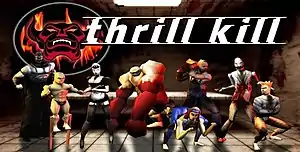Thrill Kill
Thrill Kill is a cancelled fighting video game developed by Paradox Development for the PlayStation. Originally intended to be released in 1998, the game's plot involves ten people who all get sent to Hell after dying on Earth and are forced by Marukka, the Goddess of Secrets, to fight to the death for a chance at reincarnation. It was marketed as the first four-player 3D fighting game, as up to four players were able to play at once using the PlayStation Multitap. Each player is given a "kill meter" that increases with each successful attack, which, once filled, executes a gory finishing move called a "Thrill Kill".
| Thrill Kill | |
|---|---|
 European cover art | |
| Developer(s) | Paradox Development |
| Publisher(s) | Virgin Interactive |
| Producer(s) |
|
| Designer(s) | Benjamin Kutcher |
| Programmer(s) | Peter Jefferies |
| Artist(s) | Paul Interrante |
| Writer(s) | Brian Gomez |
| Composer(s) | Keith Arem |
| Platform(s) | PlayStation |
| Release | Cancelled |
| Genre(s) | Fighting |
| Mode(s) | Single-player, multiplayer |
Thrill Kill began development as Earth Monster, a sports video game based on the Mesoamerican ballgame in which characters attacked one another as they tried to get a ball into a hoop. As developers were repeatedly pushed by publisher Virgin Interactive to make the game more violent, Earth Monster's concept was scrapped in favor of an adult-oriented, BDSM-themed fighting game. It gained a large following prior to its release for its overtly sexual and gory content, and received one of the first-ever "Adults Only" (AO) ratings from the Entertainment Software Rating Board (ESRB), also becoming the first game to receive the rating for its violence.
Reviewers of the beta version of Thrill Kill considered it fun but unfinished. The game was scheduled to be published by Virgin Interactive, but Electronic Arts gained the publishing rights the same year and chose not to release the game or sell it to other publishers due to its graphic content. Bootleg versions of the game were nonetheless uploaded to pirating websites and it became especially popular as a ROM. Following its cancellation, Thrill Kill was reskinned to make the 1999 Activision video game Wu-Tang: Shaolin Style, also developed by Paradox, who went on to use Thrill Kill's engine in several of their other games.
Gameplay

The gameplay consists of up to four opponents in a closed 3D room fighting to kill one another one-by-one using gory special moves known as "Thrill Kills". The four attack buttons correspond to each character's arms and legs, while attacks are blocked by standing still or by holding down the guard button. Double tapping in any direction allows players to dash. Each character has four throws, including a "Swap Throw", which causes the player who performs it and the opponent to switch places, and a "Hold Throw", which pins opponents down in front of the character that performs it. Characters can also perform both high and low counter hits.[1]
Instead of the usual life bar, characters have a "kill meter" that increases with each successful attack performed. Whichever character fills this meter first must use a Thrill Kill on one other opponent of their choice, which kills them and removes them from the round. The manner of the kill depends on the button input upon grabbing the other character. The round then repeats without the defeated character, with the character who performed a Thrill Kill in the prior round earning a small boost to their kill meter at the start of the round. This continues until there are two fighters left, and whichever fighter's kill meter fills up first wins, triggering a final, character-specific death animation.[2][3]
Players can choose from four different modes. "Arcade Mode" puts players through eight stages against computer-controlled opponents, the first six of which are four-player matches, while the latter two are one-on-one battles against the characters Judas and Marukka, respectively. "Versus Mode" allows players to fight with up to three other players or computer-controlled fighters. In order to play with all four players, players required the PlayStation Multitap.[4] "Team Mode" splits players into two teams, with each team sharing a single kill meter. "Training Mode" is a single-player mode which allows players to test individual characters' moves on a computer opponent; performing each move in a character's moveset in this mode unlocks a fifth costume for the character.[1] Stages include Dante's Cage, the Crematorium, Sacrificial Ruins, Chamber of Anguish, the Lavatory, Insane Asylum, Slaughterhouse of Flesh, Sewer of Styx, Sinner's Cell, and Homicide Avenue.[5]
Characters

In the story of Thrill Kill, Marukka decides out of boredom to gather ten people who have been sent to Hell for their sins to fight to the death for a chance at being reincarnated. There are eleven playable characters:[1][2]
- Belladonna: A librarian who became a dominatrix and killed both her husband and sister after discovering that they were having an affair. She died after electrocuting herself with a cattle prod.[6] She now uses this prod to fight and has sexually suggestive moves.
- Cain: An arsonist who got trapped inside a building he set on fire and was burned alive. His attacks have the widest reach in the game and he can also shoot fire out of his backside.
- Cleetus: A cannibal who sold "homestyle" sausages made from human remains, and died due to a tapeworm infection from one of his victims. He fights using a bloody, detached leg, and can also bite his opponents.
- Dr. Faustus: A plastic surgeon who killed and purposely disfigured his patients and died from infection after affixing a bear trap to his face. His weapon is a scalpel and he also attacks using his metal mouth.
- The Imp: A dwarf "leather daddy" with a hatred for tall people, who died after amputating his legs and sticking stilts in them. Unlike the rest of the characters (excluding Judas), The Imp is not revealed to have killed anyone during his time on Earth. He uses his stilts as weapons. Some members of Paradox's team resented Thrill Kill producer Harvard Bonin for attempting to change the game to give it a different ESRB rating, and modeled The Imp after Bonin as a jab at him.[4]
- Judas: A pair of conjoined twins connected at the torso. It is never explained how Judas ended up in Hell. While one twin acts as the upper half, the other twin acts as the lower half, using their arms to hold them up.
- Mammoth: A postal employee who "went postal" after getting fired. He resembles a large, skinless gorilla and fights with his fists.
- Marukka: A demon and the "Goddess of Secrets" who gathers the other fighters to brawl for a chance at being reincarnated. While fighting, she can teleport.
- Oddball: An FBI behavioral analyst who became a serial killer. He still wears a straitjacket in Hell and can’t use his arms, so he primarily uses kicks and headbutts to attack, and can also use breakdancing to fight.
- Tormentor: A judge (real name William Whitefield) who would acquit criminals in order to kidnap and torture them later, and was eventually executed for his crimes. His outfit is bondage-themed, and he fights using a heated whip.
- Violet: A circus contortionist who developed a strong hatred for men after being raped by one who broke into her dressing room, whom she later killed. She died of a spinal cord rupture. She uses her contortion skills to fight opponents.
A twelfth non-player character, The Gimp, inspired by "the gimp" from the 1994 film Pulp Fiction, can be unlocked as an opponent in Training Mode.[5]
Development and cancellation
In the late 1990s, Paradox Development began development on a PlayStation game titled Earth Monster, a fantasy sports game based on the Mesoamerican ballgame where players would control large, muscular Aztec warriors who punched and kicked one another while trying to get a ball into a hoop. The game's publisher, Virgin Interactive, repeatedly encouraged the developers to make the fighting aspect more violent, before eventually deciding to turn the project entirely into a fighting game. Its Aztec aesthetic was soon replaced by one inspired by BDSM and intended by Virgin to cause controversy, which they hoped would help it sell better. Harvard Bonin, the producer assigned to Thrill Kill, showed developers fetish magazines, such as Skin Two, and BDSM DVDs as references for the desired art direction.[4]
Designed as an especially violent, "full-blown adult" fighting game and the first four-player 3D fighting game, Thrill Kill was meant to compare to the similarly violent Mortal Kombat series.[7] Paradox hoped that the game's success would help the studio earn mainstream recognition. The plot of Thrill Kill, based around each of the characters fighting for a chance at resurrection after being sent to Hell, was written by the game's assistant producer, Brian Gomez, and inspired by the musical Cats. Moves were given names such as "Bitch Slap", "Swallow This", "Crotch Crush", and "Miner 69er", and several were designed to resemble sexual acts.[8][9] According to Bonin, the kill meter system was designed to "promote in-your-face aggression" to contrast Thrill Kill from other fighting games that encouraged players to focus on defending their own character.[10] After E3 1998, where Thrill Kill was nominated as the most popular game presented at the event, it gained a large following due to its gory and sexual nature.[11] It received one of the first "Adults Only" (AO) ratings from the Entertainment Software Rating Board (ESRB) after it was submitted, and became the first game to receive the rating solely due to violence as opposed to the rating usually being only given to games with strong sexual/pornographic content. As of 2023, only three other games (Manhunt 2, Hatred and an unreleased version of The Punisher) ever received an AO rating solely for extreme, graphic violence.[12] This prompted Virgin and Bonin to try and get developers to tone down the game's content to get it to a "Mature" (M) rating, as an AO rating would prevent it from being sold in many stores.[4][10]
Thrill Kill was originally set to be released in October 1998.[10] One strategy proposed by Virgin to promote it was to send copies to those opposed to video game violence. In August 1998, the North American operations of Virgin Interactive were acquired by Electronic Arts as part of their purchase of Westwood Studios, which led to EA gaining the publishing rights to Thrill Kill. After evaluating the game, EA's executive board deemed its tone too violent for publication. By this point, according to senior programmer David Ollman, the game was already 99% finished and a sequel had been proposed, the name of which would have either been F.U.B.A.R or S&M.[9] Two weeks after acquiring Virgin, the company discontinued the game and declined offers to sell it to other publishers, including Eidos Interactive. According to Louis Castle, founder of Westwood Studios, "EA...was working hard to overcome the industry stigma of games as a more violent medium than film or TV."[8] Members of Thrill Kill's development team were not directly informed by EA that the game was cancelled and instead found out by reading articles about it on the Internet, according to producer Kevin Mulhall. In later interviews, Paradox employees such as Mulhall and Ollman pointed to EA's connections with United States Senator Joe Lieberman, who was staunchly and vocally opposed to video game violence, as an explanation for EA's decision to cancel the game.[4][9]
Although it was never made available for retail purchase, bootleg versions of the game were uploaded to pirating websites by its developers, and it became one of the most popular and frequently downloaded ROMs on the Internet.[9][13] Thrill Kill was later reskinned by Paradox and used to make the 1999 PlayStation fighting game Wu-Tang: Shaolin Style, published by Activision and based on the rap group Wu-Tang Clan.[7] The Thrill Kill engine later became a core technology for Paradox, and was used in two-player form for the 2000 game X-Men: Mutant Academy, its 2001 sequel X-Men: Mutant Academy 2, and the 2000 game Rock 'Em Sock 'Em Robots Arena.[14][15][16]
Reception and legacy
In a review of the beta version of Thrill Kill, Gamers' Republic's Mike Griffin wrote, "[Thrill Kill is] perfect for mindless fun with friends and cold drinks. Mindless, but not brainless. There should be enough depth to the gameplay to satisfy hard-core 3D fighting fans once Paradox has completed its final few months of dedicated beta tweaking." Griffin also stated, "There are a few bugs right now that prevent Thrill Kill from being completely effective."[2] Also reviewing the game's beta version, IGN's Jeff Chen wrote, "The action at this point is somewhat stiff, but it's still early, and if you're looking for blood and guts, this has got more than we'd ever imagined. We can't wait."[3]
In their September 2004 issue, Official U.S. PlayStation Magazine cited Thrill Kill as one of the most overrated cancelled games, stating, "It got lots of hype. But it really sucked, too."[17] In 2011, GamePro ranked The Imp fourteenth on a list of "The 50 Best Fighting Game Characters Ever".[18] In 2014, Metro included Thrill Kill on their list of the most offensive games of all time, while Complex named Thrill Kill the seventh most violent video game.[19][20] IGN named Thrill Kill on their list of the biggest unreleased games.[21]
Steven T. Wright of Variety considered Thrill Kill "perhaps the most notorious unreleased game in the history of the industry", while, in 2012, IGN wrote that it was "perhaps the most famous cancelled game in recent memory".[4][3] In a 2013 article for The Manitoban, Marc Lagace called the game "a complete disaster, both aesthetically and gameplay-wise" and "perhaps the most controversial game that never was".[22] Writing for Kotaku Australia, Leah Williams wrote, "To look at it now, it all seems a bit naff — but way back in 1998, the content of Thrill Kill was extremely controversial."[13] Den of Geek's Gavin Jasper called Thrill Kill, Tattoo Assassins, and Primal Rage 2 the "holy trinity of almost-to-completely-finished fighting games that didn't get released".[23]
See also
References
- Bobinator (January 22, 2012). "Thrill Kill". Hardcore Gaming 101. Archived from the original on March 1, 2021. Retrieved April 16, 2021.
- Griffin, Mike (September 1998). "Thrill Kill". Gamers' Republic. No. 4. Millennium Publications. p. 43. Retrieved April 17, 2021.
- "Thrill Kill". IGN. July 10, 1998. Archived from the original on April 17, 2021. Retrieved April 17, 2021.
- Wright, Steven T. (February 15, 2019). "The Secret History of Wu-Tang Clan's Bizarre Hip-Hop Fighting Game". Variety. Archived from the original on April 15, 2021. Retrieved April 15, 2021.
- Fielder, Lauren (April 28, 2000). "Virgin's Thrill of Killing: The Full Story". GameSpot. Archived from the original on May 1, 2021. Retrieved May 1, 2021.
- Ashcraft, Brian (May 12, 2011). "Controversial Game Brought To Life With Tight Rubber, Nice Lady". Kotaku Australia. Archived from the original on April 17, 2021. Retrieved April 17, 2021.
- Carpenter, Alexander (March 25, 2014). ""Wu Tang Shaolin Style": 15 Years Later, Why a Terrible Game is Still Hugely Important". Complex. Archived from the original on April 17, 2021. Retrieved April 17, 2021.
- Kent, Steven (October 16, 1998). "EA kills 'Thrill Kill' game before release". ZDNet. Archived from the original on January 26, 2021. Retrieved April 15, 2021.
- Lipscombe, Daniel (July 17, 2018). "The story of Thrill Kill, a PS1 fighting game canned by EA for being too controversial". VG247. Archived from the original on April 15, 2021. Retrieved April 15, 2021.
- Thorpe, Nick (October 29, 2020). "Whatever Happened to... Thrill Kill". Retro Gamer. No. 213. Future plc. pp. 79–80. Retrieved April 17, 2021.
- Huffstutter, P.J.; Oldham, Jennifer (May 17, 1999). "Video Game Industry Split on Violence Issue". Los Angeles Times. Archived from the original on April 17, 2021. Retrieved April 17, 2021.
- "Hatred gets Adults Only rating, making console, Steam release unlikely". Ars Technica. January 17, 2015. Archived from the original on April 17, 2021. Retrieved April 17, 2021.
- Williams, Leah (February 1, 2021). "The Wildest 'Lost And Found' Discoveries In Gaming History". Kotaku Australia. Archived from the original on April 17, 2021. Retrieved April 17, 2021.
- Bishop, Sam (July 14, 2000). "X-Men: Mutant Academy". IGN. Archived from the original on May 2, 2021. Retrieved May 2, 2021.
- Zdyrko, Dave (September 1, 2000). "Rock 'em Sock 'em Robots Arena". IGN. Archived from the original on October 25, 2020. Retrieved May 2, 2021.
- Perry, Douglass C.; Zdyrko, Dave (July 27, 2001). "X-Men: Mutant Academy 2". IGN. Archived from the original on May 2, 2021. Retrieved May 2, 2021.
- OPM staff (September 2004). "Overrated/Underrated" (SWF transcript Archived December 19, 2008, at the Wayback Machine). Official U.S. PlayStation Magazine
- "The 50 Best Fighting Game Characters Ever" GamePro 2011/Winter.
- Waugh, Rob (October 18, 2014). "Forget Hatred - these are the most offensive games of all time". Metro. Archived from the original on April 17, 2021. Retrieved April 17, 2021.
- "The 25 Most Violent Video Games". Complex. March 22, 2014. Archived from the original on April 17, 2021. Retrieved April 17, 2021.
- Johnson, Leif (January 4, 2019). "The 13 Biggest Video Games That Never Came Out". IGN. Archived from the original on April 27, 2021. Retrieved April 25, 2021.
- Lagace, Marc (January 23, 2013). "Some games are best left unreleased: Playing the infamous game, Thrill Kill". The Manitoban. Archived from the original on April 17, 2021. Retrieved April 17, 2021.
- Jasper, Gavin (February 8, 2021). "50 Best Fighting Game Final Bosses from Street Fighter, Mortal Kombat, Tekken, and More". Den of Geek. Archived from the original on February 23, 2021. Retrieved April 17, 2021.